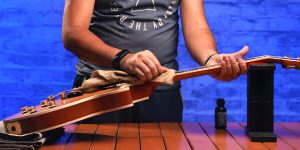Today, we are diving into the fascinating world of violin maintenance with a step-by-step guide on how to rosin a violin bow. If you’ve ever wondered why the violin produces such a rich, warm, and clear sound, then rosin, that seemingly insignificant amber-hued cake, is a huge part of the secret. It’s a main component for optimal sound reproduction, as it creates the necessary friction between the bow and the strings to elicit beautiful notes from your instrument.
So, grab your violin, bow, and rosin, and let’s embark on this journey to understand the importance of this process and how to do it right.
Understanding rosin

At first glance, rosin might seem like nothing more than a small, amber-colored chunk of resin. But don’t let its humble appearance fool you. Without it, your violin would be a different beast altogether.
But what is rosin, exactly? Derived from pine trees, rosin is a hardened sap that varies in color from yellow to deep black. The color often reflects the level of stickiness and grip, with lighter rosins typically providing a smoother grip and darker rosins offering more bite.
The main purpose
The primary function of rosin is to create friction. By rubbing rosin on your violin bow, its hairs are provided with the necessary grip to catch and vibrate the strings of your instrument. The friction ensures that the strings will vibrate and produce sound when the bow moves across the violin strings. Without it, the bow would slide smoothly over the strings without producing much noise.
Choosing the right rosin
Rosin comes primarily in two types – dark and light. To understand which might be the best fit for you, let’s quickly break down their characteristics:
| Type of rosin | Characteristics |
|---|---|
| Dark Rosin | Dark rosin is typically stickier and heavier than its light counterpart. It provides a greater grip on the strings, resulting in a warmer, richer tone. It’s especially preferred in colder climates as it maintains consistency better in lower temperatures. |
| Light Rosin | Light rosin is harder and less sticky than dark ones. It offers less grip on the strings and produces a lighter, more delicate tone. Players often prefer it in warmer climates because it doesn’t get overly sticky in the heat. |
Now, how do you choose the right rosin? The choice depends on several factors. First, your preference for the kind of tone you want to produce – rich and warm or bright and delicate – will heavily influence your decision. Additionally, the type of music you usually play may also guide your choice. For instance, if you play a lot of fast, lively music, a light rosin that offers a quick response might be your best bet.
Step-by-step instructions on how to rosin the bow

Now that we’ve explored the importance of rosin and its role in making music, it’s time to get down to the nitty-gritty – the step-by-step process of how to rosin a violin bow.
Preparing the bow
Ensuring the bow hair is clean and in good condition is paramount to achieving a superior sound.
The bow hair is typically made from horsehair. Over time and through rosin up the bow, this hair can collect dust, dirt, and oil from our fingers, affecting the rosin’s grip and, thus, the sound production. Therefore, before we apply the rosin, we must ensure the bow hair is clean and free of debris.
Applying rosin
Let’s get started with our first step on how to rosin a violin bow:
- Secure the violin. Begin by placing your violin safely on a stable surface or securely in its case to ensure that it won’t be knocked over while you’re focusing on the bow.
- Hold the rosin. Now, take your stick of rosin in one hand. You want to grip it firmly but comfortably, ready to meet the bow.
- Apply rosin to a violin bow. Hold your bow by the frog (the end closest to you when you’re playing) with your other hand. Now, starting at the frog, lightly run the rosin up along the hairs of the bow to the tip. Ensure you apply even pressure so the rosin transfers onto the bow hairs. You may need to repeat this process a few times, especially if the bow is new or hasn’t been rosined for a while.
- Clean up excess rosin. After you’ve used rosin for the violin, gently tap the bow against the edge of the rosin box or use a clean, dry cloth to remove any excess rosin from the bow hair. This will prevent dusting rosin onto your violin, which could potentially damage the finish.
Step one of learning to put rosin on a violin bow is completed. This may seem like a small part of your violin journey, but it plays a vital role in ensuring the beautiful sound quality of your instrument.
Rosin maintenance
Proper rosin maintenance ensures it does its job effectively and lasts longer. So, here are some simple yet crucial tips for taking care of your rosin.
- Storage: Store your instrument in a cool and dry place, away from direct sunlight and sudden temperature changes. I highly recommend keeping your rosin in its original packaging or a protective rosin case. It helps shield the rosin from environmental factors that could compromise its performance.
- Cleanliness: Use a soft, lint-free cloth or a clean brush designed specifically for rosins to keep its surface clean. This helps maintain the rosin’s integrity and prevents unwanted particles from sticking to your bow hair during application.
- Refreshing rosin: If you start noticing a reduction in friction or if it seems like there’s not enough rosin being transferred to your bow hair, it’s time to refresh your rosin. Gently scrape the surface of the rosin with a knife or a rosin scraper to expose a fresh layer.
Treat your rosin with respect and care, and it will reward you with beautiful sounds for a long time!
FAQ
How often should I rosin my bow?
The frequency can vary depending on your playing habits. Generally, it’s better to rosin the bow every 3-4 hours of playtime. However, it might be time to reapply if you notice a lack of friction between your bow and the strings.
Can I use rosin powder instead of solid rosin?
Yes, you can! Rosin powder, also known as ‘ground rosin’, works similarly to rosin cake. It provides the same level of friction necessary for sound production.
How often should I clean the bow hair?
Ideally, you should clean your bow hair every time you re-hair your bow, which is typically every 6 months to a year.
Can I use rosin on other bows, such as cello or viola bows?
Absolutely! In fact, it’s a must. All string instruments – violins, violas, cellos, and double basses – require rosin for sound production.











